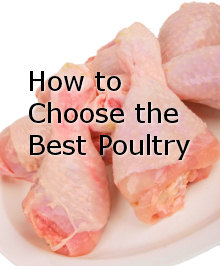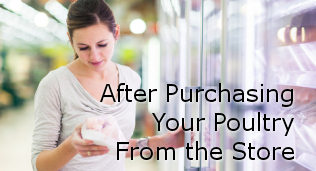Poultry guide | Including storing fresh and frozen chicken, turkey and duck.

Welcome to our poultry guide.
All poultry produce can be purchased from your local supermarket or from a butcher. It is a good idea to check out different supermarkets to compare prices and quality of meat.
Once you are satisfied that you have found a store that sells good quality, fresh poultry at a reasonable price, always buy your poultry or other meat products there, so that you know what you are getting, for how much and that the hygiene standards are upheld.
All poultry produce can be purchased from your local supermarket or from a butcher. It is a good idea to check out different supermarkets to compare prices and quality of meat.
Once you are satisfied that you have found a store that sells good quality, fresh poultry at a reasonable price, always buy your poultry or other meat products there, so that you know what you are getting, for how much and that the hygiene standards are upheld.
Our poultry-related articles
Defrosting Poultry
How to safely defrost poultry in the refrigerator, microwave or in cold water including defrosting times.
How to safely defrost poultry in the refrigerator, microwave or in cold water including defrosting times.
Boning Poultry
How to remove the bones from whole birds and also poultry pieces such as chicken or turkey breasts.
How to remove the bones from whole birds and also poultry pieces such as chicken or turkey breasts.
Jointing Poultry
How to joint poultry including steps on dividing a whole bird into portions of breast, wings, thigh and drumsticks.
How to joint poultry including steps on dividing a whole bird into portions of breast, wings, thigh and drumsticks.
Trussing Poultry
How to truss poultry such as chicken or turkey before roasting with details for both stuffed and unstuffed birds.
How to truss poultry such as chicken or turkey before roasting with details for both stuffed and unstuffed birds.
Stuffing Poultry
How to stuff a whole chicken or turkey including recipes for the most popular homemade stuffing.
How to stuff a whole chicken or turkey including recipes for the most popular homemade stuffing.
Carving Poultry
General tips, information and detailed instructions on how to carve a whole chicken, turkey or duck.
General tips, information and detailed instructions on how to carve a whole chicken, turkey or duck.
How to Roast a Chicken
How to clean, prepare, season, truss and roast a whole chicken with roasting times per pound of meat.
How to clean, prepare, season, truss and roast a whole chicken with roasting times per pound of meat.
Chicken Recipes
International chicken recipes including chicken satay, chicken casserole, tikka masala and more.
International chicken recipes including chicken satay, chicken casserole, tikka masala and more.
How to Roast a Turkey
How to prepare and roast a whole turkey including how to clean, season, stuff, truss and roast the turkey.
How to prepare and roast a whole turkey including how to clean, season, stuff, truss and roast the turkey.
Turkey Recipes
Orange Turkey with rice, Cranberry Turkey Rolls, Lemon and Sage Turkey Breasts, Kiev and more
Orange Turkey with rice, Cranberry Turkey Rolls, Lemon and Sage Turkey Breasts, Kiev and more
How to Roast a Duck
How to roast a duck, remove the layer of fat and ensure a crispy skin including roasting times.
How to roast a duck, remove the layer of fat and ensure a crispy skin including roasting times.
Duck Recipes
Recipes with duck including Peking duck, duck with lime and ginger and crispy duck with noodles.
Recipes with duck including Peking duck, duck with lime and ginger and crispy duck with noodles.
Poultry Stock Guide
Instructions and recipe ideas on how to make a homemade poultry stock from leftover poultry.
Instructions and recipe ideas on how to make a homemade poultry stock from leftover poultry.
Poultry Gravy Guide
How to make a homemade poultry gravy from drippings after roasting a whole bird including three recipes.
How to make a homemade poultry gravy from drippings after roasting a whole bird including three recipes.

When selecting your poultry, whether you are buying a whole bird or smaller cuts of meat, always buy meat that has a healthy appearance and colour and does not possess any defects.
If choosing a whole fresh chicken or turkey, Grade A products, which are the best, will have plump bodies, perfect skin and will be free from any imperfections such as cuts, bruises or broken bones.
If choosing a whole fresh chicken or turkey, Grade A products, which are the best, will have plump bodies, perfect skin and will be free from any imperfections such as cuts, bruises or broken bones.
Also make sure that the poultry has been refrigerated and properly covered when on display in the store. Ensure that you buy poultry meat from a shop that has a high turnover and where meat is replaced daily if possible, in order to guarantee freshness and so that you do not buy any meat that has been left out for several days.
When buying your poultry from the supermarket, make certain that you do all your other shopping first and that you select the poultry last, just before reaching the check-out, as this will reduce the amount of time the poultry is spent outside of the fridge or freezer.
On choosing poultry from the meat department, look for packaging that does not contain any holes or tears and make sure that the meat is cool to the touch, so that you are certain that it has been adequately stored.
Also be aware of packages that have been stacked too high and that may be stored above the adequate storage level of the supermarket fridge or freezer. This would mean that the poultry would not be chilled properly and could result in the growth of bacteria, thus making the poultry meat less safe to eat.
The meat would therefore have to be prepared and cooked much sooner. As long as the poultry meat is cooked at sufficiently high temperatures, all the bacteria will be killed and destroyed.
If you are buying a frozen bird from the supermarket, it should be extremely hard to touch and show no signs of freezer damage. If ice crystals are present on the surface of the packaging, it means that the poultry has been stored at temperatures that are much too cold.
Poultry can be used or frozen within two days of its "sell by" date and should be cooked by its "use-by" date. The meat will be at its best before or on the "use-by" date, however it can still be cooked after this date, although the quality of the meat will start to deterioate.
Poultry is a perishable product, so if you have any doubts about the quality of the meat, it is best to throw it out, especially if there are signs of deterioration such as a foul smell or an off colour.
When choosing a whole turkey or a whole chicken, allow 1 lb (450 g) of meat per person if you are unsure of how big a bird to buy. Therefore, if you are cooking for five people, you will need a bird that weighs around 5 lb (2.2 kg).
Once at the check out, place the poultry in a separate plastic bag, away from the other goods, preferably wrapping it in one bag first and then placing this bag inside another plastic bag. This will keep the meat away from other products, especially fresh fruit and vegetables and consequently prevent contamination that could occur from meat juices dripping onto the other goods.
Advertisements

On leaving the supermarket, try to take the poultry home immediately and refrigerate or freeze it as soon as possible upon arrival, before the meat starts to get too warm and bacteria begins to grow.
Bacteria thrives and multiplies rapidly at warm temperatures, yet grows very slowly in the refrigerator. For this reason you should store the poultry in the coldest part of the fridge immediately.
Poultry should never be kept at room temperature for more than three hours and should not be left in a hot car, as it is an extremely perishable food.
If you are not planning on cooking the poultry within two days of purchase, it must be stored in the freezer. It can be frozen in its original packaging or it can be repackaged. For a whole bird, it is probably best to keep it in its original packaging and then wrapping it with cling film several times.
Try to avoid using plastic bags from the supermarket, as the chemicals from the print and colouring of the plastic may contaminate or react with the meat.
Chicken or turkey pieces can be wrapped in meal-size portions in cling film or polythene freezer bags. To save money you could buy family packs of poultry pieces and then repackage them into smaller portions. It would be a good idea to clearly label each package with the contents and the date placed into the freezer.
Make sure that the portions are properly wrapped otherwise "freezer burn" could develop. Freezer burn appears as grey-brown spots on the meat that is caused by air reaching the surface of the poultry meat.
Any pieces of meat containing freezer burn should be cut away either before or after cooking. If a lot of freezer burn is present, the meat could turn out to be very dry and tasteless when cooked.
Once you plan to cook the frozen turkey or chicken, make sure that you calculate well in advance how long you will need to defrost the poultry and store it in the freezer until then (see the link below for our section on defrosting poultry).
Fresh poultry products should be stored in the fridge for one or two days before cooking. However, cooked chicken or turkey meat can be kept for longer. For example leftover poultry such as chicken pieces, chicken casserole or a chicken or turkey salad can be kept in the fridge for three to four days.
However, any chicken or turkey that has a sauce or gravy covering it, should only be kept for one or two days at the most.
The meat should be placed in a fridge that maintains a temperature of 40°F or below and if you choose to reheat the chicken or turkey rather than eat it cold, then make sure that you reheat the meat to a temperature of at least 165°F (75°C).
Bacteria thrives and multiplies rapidly at warm temperatures, yet grows very slowly in the refrigerator. For this reason you should store the poultry in the coldest part of the fridge immediately.
Poultry should never be kept at room temperature for more than three hours and should not be left in a hot car, as it is an extremely perishable food.
If you are not planning on cooking the poultry within two days of purchase, it must be stored in the freezer. It can be frozen in its original packaging or it can be repackaged. For a whole bird, it is probably best to keep it in its original packaging and then wrapping it with cling film several times.
Try to avoid using plastic bags from the supermarket, as the chemicals from the print and colouring of the plastic may contaminate or react with the meat.
Chicken or turkey pieces can be wrapped in meal-size portions in cling film or polythene freezer bags. To save money you could buy family packs of poultry pieces and then repackage them into smaller portions. It would be a good idea to clearly label each package with the contents and the date placed into the freezer.
Make sure that the portions are properly wrapped otherwise "freezer burn" could develop. Freezer burn appears as grey-brown spots on the meat that is caused by air reaching the surface of the poultry meat.
Any pieces of meat containing freezer burn should be cut away either before or after cooking. If a lot of freezer burn is present, the meat could turn out to be very dry and tasteless when cooked.
Once you plan to cook the frozen turkey or chicken, make sure that you calculate well in advance how long you will need to defrost the poultry and store it in the freezer until then (see the link below for our section on defrosting poultry).
Fresh poultry products should be stored in the fridge for one or two days before cooking. However, cooked chicken or turkey meat can be kept for longer. For example leftover poultry such as chicken pieces, chicken casserole or a chicken or turkey salad can be kept in the fridge for three to four days.
However, any chicken or turkey that has a sauce or gravy covering it, should only be kept for one or two days at the most.
The meat should be placed in a fridge that maintains a temperature of 40°F or below and if you choose to reheat the chicken or turkey rather than eat it cold, then make sure that you reheat the meat to a temperature of at least 165°F (75°C).
Advertisements














